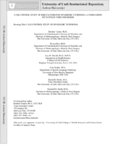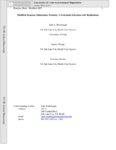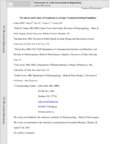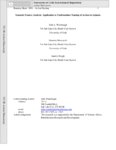TO
Filters: Department: "Communication Sciences and Disorders" Collection: "ir_uspace" Year Start: 2012
1 - 25 of 7
| Creator | Title | Description | Subject | Date | ||
|---|---|---|---|---|---|---|
| 1 |
 | Wambaugh, Julie L. | Acquired apraxia of speech: the effects of repeated practice and rate/rhythm control treatments on sound production accuracy | Purpose: This investigation was designed to elucidate the effects of repeated practice treatment on sound production accuracy in individuals with apraxia of speech (AOS) and aphasia. A secondary purpose was to determine if the addition of rate/rhythm control to treatment provided further benefits be... | 2012-01-01 | |
| 2 |
 | Roy, Nelson | Case-control study of risk factors for spasmodic dysphonia: a comparison with other voice disorders | Objectives: This epidemiology study examined risk factors uniquely associated with spasmodic dysphonia (SD). Study Design: Case-control. Methods: A questionnaire was administered to 150 patients with SD (with and without coexisting vocal tremor) and 136 patients with other structural, neurological, ... | 2012-01-01 | |
| 3 |
 | Chapman, Kathy L. | Early lexical characteristics of toddlers with cleft lip and palate | Main Outcome Measures: The groups were compared for size of expressive lexicon reported on the MacArthur Communicative Development Inventory and the percentage of words beginning with obstruents and sonorants produced in a language sample. Differences between groups in the percentage of word initial... | 2014-01-01 | |
| 4 |
 | Wambaugh, Julie L. | Modified response elaboration training: a systematic extension with replications | Background: Response Elaboration Training (RET; Kearns, 1985) has been found to consistently result in increased production of content in discourse with persons with aphasia. Positive treatment effects have been reported for persons representing a variety of aphasia types and severities. RET was mod... | 2012-01-01 | |
| 5 |
 | Haysley, Sarah and Jennings, Skyler | Preliminary evidence of distorted tonotopy in Humans | The cochlea topographically arranges the frequencies of a complex sound from base (high-frequencies) to apex (low-frequencies) across the basilar membrane. From this tonotopic map, auditory neurons will phase lock to a sound's slow-varying temporal envelope (ENV) and to the faster fluctuating tempor... | Distorted tonotopy; evoked potentials; hearing loss; compound action potential; envelope following response; extended high frequency hearing thresholds | 2024 |
| 6 |
 | Roy, Nelson | Prevalence and causes of dysphonia in a large treatment-seeking population | Objective: To determine the prevalence and common causes of dysphonia as diagnosed by primary care physicians (PCPs) and otolaryngologists, and to evaluate differences in etiologies offered by these providers. Study Design: Retrospective analysis of data from a large, nationally representative admin... | 2012-01-01 | |
| 7 |
 | Wambaugh, Julie L. | Semantic feature analysis: Application to confrontation naming of actions in aphasia | Background: Despite advances in the development and testing of therapies for verb retrieval impairments in aphasia, generalization effects of treatment remain a challenge. Semantic Feature Analysis (SFA) is a word retrieval treatment that has been reported to result in generalized responding to untr... | 2014-01-01 |
1 - 25 of 7
